
The complete guide on Yoga – its introduction, rich history, importance, benefits, and essential yoga asanas. Learn why Yoga is vital for a healthy body and mind.
Introduction to Yoga A Path to Wellness and Inner Peace
Namaste and welcome, fellow wellness seekers! If you’ve ever searched for peace, strength, or healing, you’ve likely encountered the word “Yoga.” But what is Yoga, truly? It’s far more than just twisting into impressive poses you see on social media. Yoga is a profound, 5,000-year-old journey of unifying your mind, body, and spirit. Originating in ancient India, this holistic practice offers tools – physical postures (asanas), breath control (pranayama), meditation (dhyana), and ethical principles (yamas & niyamas) – to cultivate inner harmony and vibrant health.
Think of Yoga not just as exercise, but as a transformative lifestyle. In our fast-paced world filled with stress and distraction, Yoga provides an anchor, a way to reconnect with your true self and live with greater awareness, resilience, and joy. Let’s embark on this exploration together!
Yoga is a powerful and ancient practice that helps unite the mind, body, and soul. The word Yoga comes from the Sanskrit root “Yuj,” which means “to join” or “to unite.” In today’s fast-paced life, yoga provides a much-needed balance, offering a natural remedy for stress, anxiety, and many lifestyle disorders.
Yoga is not just a form of exercise but a holistic approach to achieving overall well-being. Whether you are young or old, a beginner or experienced, yoga benefits everyone, making it a universal solution for good health.
The Rich History of Yoga
Understanding Yoga means stepping back millennia. Its history is deep and fascinating.
✔ The Seeds (Pre-Vedic & Vedic Period – 3000 BCE onwards) :- Evidence suggests practices resembling Yoga existed in the ancient Indus Valley Civilization (think seals depicting meditative figures). The earliest written mentions appear in the Vedas, ancient Indian scriptures (circa 1500-500 BCE), particularly the Rig Veda, which speaks of discipline and harnessing the senses.
✔ The Upanishads & Philosophical Foundations (800-500 BCE) :- The Upanishads (later Vedic texts) shifted focus inward, introducing core concepts like meditation, breath control, and the exploration of the true Self (Atman) and its connection to the universal consciousness (Brahman). This era laid the groundwork for Yoga as a spiritual path.
✔ The Bhagavad Gita & Paths of Yoga (circa 500-200 BCE) :- This epic dialogue between Prince Arjuna and Lord Krishna is a cornerstone of Yoga philosophy. It outlines different paths (Yogas) suited to different temperaments: Karma Yoga (selfless action), Bhakti Yoga (devotion), and Jnana Yoga (knowledge/wisdom).
✔ The Classical System: Patanjali’s Yoga Sutras (circa 200 BCE – 400 CE) :- This is where Yoga as we commonly understand it was systematically codified. Sage Patanjali compiled the “Yoga Sutras,” defining Yoga as “the stilling of the fluctuations of the mind” (Yogas chitta vritti nirodhah). He outlined the famous Eight Limbs of Yoga (Ashtanga Yoga), providing a practical roadmap for ethical living, physical practice, breathwork, and meditation leading to enlightenment (Samadhi).
✔ Post-Classical & Tantric Yoga (500 – 1500 CE) :- This period saw a shift towards harnessing the body’s energy for spiritual awakening. Hatha Yoga emerged, focusing explicitly on asanas (postures) and pranayama (breath control) to purify the body and balance subtle energies (prana). Key texts like the Hatha Yoga Pradipika were written. Tantra explored ritual, mantra, and visualization.
✔ Yoga Comes West (Late 19th Century onwards) :- Pioneers like Swami Vivekananda introduced Yoga philosophy to the West at the Parliament of Religions (1893). In the mid-20th century, influential teachers like T. Krishnamacharya and his students (B.K.S. Iyengar, Pattabhi Jois, T.K.V. Desikachar) developed and popularized the physical styles (Hatha, Iyengar, Ashtanga Vinyasa) dominant globally today.
✔ Modern Yoga :- Today, Yoga is a global phenomenon. While its spiritual roots remain vital for many, millions practice primarily for physical fitness, stress relief, and mental well-being. It continues to evolve, embracing scientific research and diverse interpretations while offering profound benefits accessible to all.
Why Yoga The True Purpose of Yoga in Our Life
Why has Yoga endured for millennia and exploded in popularity now? Because it delivers tangible, life-changing benefits across every dimension of your being.
1. Physical Powerhouse :-
Strength & Flexibility :- Asanas build functional muscle strength while dramatically improving flexibility and joint range of motion, combating stiffness from modern sedentary life.
Pain Relief :- Regular practice alleviates common aches like back pain, neck tension, and arthritis symptoms by improving posture, alignment, and circulation.
Vitality & Immunity :- Stimulates circulation, supports lymphatic drainage, massages internal organs, and can boost immune function. Feel more energized!
Balance & Coordination :- Many poses enhance proprioception (body awareness) and stability, reducing fall risk, especially as we age.
2. Mental & Emotional Sanctuary :-
Stress Slayer Supreme :- Yoga is renowned for reducing cortisol (the stress hormone). Breathwork and meditation activate the parasympathetic nervous system, triggering deep relaxation. Find calm amidst chaos.
Anxiety & Depression Relief :- Studies show Yoga can significantly reduce symptoms of anxiety and mild depression, promoting feelings of peace and well-being by regulating mood pathways.
Sharper Mind :- Improves focus, concentration, memory, and cognitive function. Quiets the “monkey mind” for clearer thinking.
Emotional Resilience :- Cultivates mindfulness, allowing you to observe emotions without being overwhelmed, fostering greater emotional stability and self-awareness.
3. Spiritual Connection (On Your Terms) :-
Inner Peace & Presence :- Yoga teaches you to be fully present in the moment, moving beyond constant mental chatter towards a profound sense of inner stillness.
Self-Discovery :- Through practice, you gain deeper insight into your patterns, thoughts, and true nature.
Sense of Oneness :- For many, Yoga fosters a feeling of connection – to oneself, to others, and to something larger than oneself, whether defined spiritually or simply as universal energy.
Importance of Yoga in Today’s World
In our hyper-connected, fast-paced, and often stressful modern lives, Yoga isn’t just nice-to-have; it’s essential preventative medicine and a vital tool for thriving.
✔ Counteracting Sedentary Lifestyles :- Hours at desks or screens wreak havoc on posture and health. Yoga offers accessible movement that counteracts stiffness, improves core strength, and promotes better alignment.
✔ Managing the Stress Epidemic :- Chronic stress is a major contributor to countless health problems (heart disease, digestive issues, burnout). Yoga provides scientifically-backed techniques to manage stress effectively and build resilience.
✔ Promoting Holistic Health :- Modern medicine often treats symptoms. Yoga addresses the root causes of imbalance by integrating physical, mental, and energetic aspects of well-being, promoting true holistic health.
✔ Accessibility & Inclusivity :- Yoga truly is for EVERY body – regardless of age, fitness level, size, or background. Modifications make it adaptable. Chairs, props, gentle styles – there’s a practice for everyone.
✔ Cultivating Mindfulness :- In an age of constant distraction, Yoga trains the mind to focus, be present, and appreciate the simple moments, enhancing overall life quality.
✔ Building Community :- Yoga studios and online communities offer connection and support, combating loneliness and fostering a sense of belonging.
Essential Yoga Asanas
Now, let’s explore some fundamental Yoga asanas. Remember: Listen to your body! Never force a pose. Breathe deeply and steadily (Ujjayi breath is common) throughout. Hold each pose for 5-10 breaths initially, building as comfortable. Consult a doctor if you have specific health concerns.
1. Tadasana (Mountain Pose)
The Foundation Stand tall, feet hip-width apart or big toes touching, heels slightly apart. Ground down through all four corners of your feet. Engage thighs, lift kneecaps slightly. Lengthen tailbone down, draw navel gently in. Roll shoulders back and down, arms resting gently by sides, palms facing thighs. Crown of the head reaching towards the sky. Gaze soft or straight ahead. Feel: Grounded, stable, aligned, dignified.

Benefits :- Improves posture, balance, and body awareness. Strengthens legs, core, and feet. Reduces flat feet. Calms the mind.
Precautions :- If balance is difficult, stand near a wall or widen stance slightly.
2. Adho Mukha Svanasana (Downward-Facing Dog)
The Rejuvenator: Start on hands and knees (Tabletop). Tuck toes, lift hips high, straightening legs as much as comfortable (knees can bend). Press palms firmly down, spreading fingers wide. Arms shoulder-width, ears in line with upper arms. Lengthen spine, drawing sit bones towards the ceiling. Heels reach towards the floor (don’t force). Feel: A deep stretch in hamstrings, calves, shoulders, spine; whole-body revitalization.
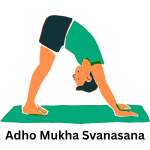
Benefits :- Stretches hamstrings, calves, shoulders, spine. Strengthens arms, shoulders, legs. Calms the brain, relieves stress and mild depression. Energizes the body. Improves digestion.
Precautions :- Avoid if you have severe carpal tunnel syndrome, high blood pressure, or detached retina. Bend knees generously if hamstrings are tight or back is rounding.
3. Virabhadrasana (Warrior II Pose)
The Empowerer From Tadasana, step feet wide apart (3.5-4 feet). Turn right foot out 90 degrees, left foot slightly in. Align right heel with left arch. Bend right knee deeply, aiming thigh parallel to floor (knee directly over ankle, not beyond toes). Extend arms out to sides at shoulder height, palms down, gaze over right fingertips. Keep torso upright, shoulders over hips. Feel: Strength in legs and core, openness in hips and chest, focused determination.
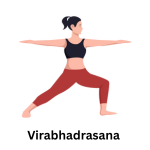
Benefits :- Strengthens legs, ankles, and core. Stretches groins, hips, chest, and shoulders. Improves stamina, balance, and concentration. Builds courage and confidence.
Precautions :- Avoid deep bend if you have knee or hip injuries. Ensure knee tracks over ankle, not collapsing inward.
4. Trikonasana (Triangle Pose)
The Energizer Start in Warrior II stance (wide legs, right foot out). Straighten right leg. Hinge at the right hip, reaching right hand down towards shin, ankle, or a block (never force to the floor). Extend left arm straight up towards ceiling. Keep both legs straight, spine long. Gaze can be down, straight ahead, or up to left thumb. Hips stay relatively level. Feel: Deep stretch along the right side body, hamstring, inner thigh; openness in chest; grounding and expansion.
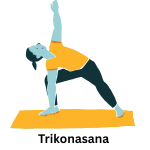
Benefits :- Stretches hamstrings, hips, groins, spine, chest, and shoulders. Strengthens legs and core. Improves digestion. Relieves stress. Enhances balance.
Precautions :- Avoid if you have low blood pressure, migraine, or neck injury (keep gaze neutral). Don’t lock knees. Use a block if needed.
5. Balasana (Child’s Pose)
The Resetter Kneel on the floor, big toes touching, knees hip-width or wider apart. Sit back on heels. Fold forward, draping torso between thighs. Rest forehead on the floor or a block. Arms can extend forward (palms down) or rest alongside body (palms up). Feel: Deep surrender, release in back, hips, shoulders; calming, introspective.
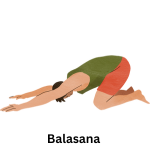
Benefits :- Gently stretches hips, thighs, ankles, and spine. Calms the brain, relieves stress and fatigue. Aids digestion. Excellent resting pose anytime.
Precautions :- Avoid if pregnant, have knee injury (use padding or widen knees significantly), or diarrhea. Place a cushion between calves and thighs if needed.
6. Bhujangasana (Cobra Pose)
The Heart Opener Lie prone (on belly), legs extended, tops of feet on floor. Place palms under shoulders, elbows hugged close to ribs. Press tops of feet and thighs firmly down. Inhale, lift head and chest off the floor using back strength, keeping a slight bend in elbows (don’t push up with arms). Roll shoulders back and down, opening the chest. Gaze slightly up or forward. *Feel: Gentle backbend strengthening spine, opening chest and shoulders.
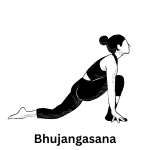
Benefits :- Strengthens spine, buttocks. Stretches chest, shoulders, abdomen. Improves posture. Can help relieve sciatica. Stimulates abdominal organs. Invigorates the heart.
Precautions :- Avoid if pregnant, have back injury (especially recent), carpal tunnel, or headache. Keep elbows bent, don’t over-arch lower back. Move gently.
7. Setu Bandha Sarvangasana (Bridge Pose)
The Revitalizer Lie on back, knees bent, feet flat on floor hip-width apart, heels close to sit bones. Arms rest alongside body, palms down. Press feet and arms firmly down. Inhale, lift hips towards ceiling, rolling spine off floor. Keep thighs parallel, knees over ankles. Clasp hands under back, rolling shoulders under, opening chest. *Feel: Strengthening in glutes, hamstrings, back; opening in chest and hips; gentle backbend.
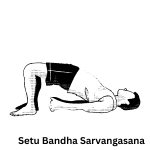
Benefits :- Strengthens back, glutes, hamstrings. Stretches chest, neck, spine. Calms brain, reduces stress. Improves digestion. Can help relieve menopause symptoms and mild depression.
Precautions :- Avoid if you have neck injury (keep head neutral). Support lower back with hands or a block if needed. Don’t force hips too high.
8. Vrikshasana (Tree Pose)
The Balancer Stand in Tadasana. Shift weight to left foot. Place right foot on left inner ankle, calf, or thigh (NEVER on knee joint). Press foot and leg firmly together. Find a steady gaze point (drishti). Bring palms together at heart center (Anjali Mudra), or raise arms overhead like branches. Keep hips level, core engaged. *Feel: Focused concentration, improved balance, groundedness through standing leg, openness in hip.
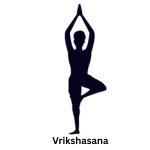
Benefits :- Dramatically improves balance, focus, and concentration. Strengthens legs, ankles, spine. Stretches inner thighs, groins, shoulders. Builds confidence and poise.
Precautions :- Use a wall or chair for support if needed. Keep foot above or below the knee, never on it. Avoid if recent ankle/knee injury.
9. Paschimottanasana (Seated Forward Bend)
The Calmer Sit tall with legs extended straight forward, feet together. Flex feet (toes towards you). Inhale, lengthen spine tall. Exhale, hinge forward from hips (not waist), leading with chest. Reach hands towards feet, shins, or use a strap. Keep back straight as long as possible before gently rounding. Relax shoulders and neck. Feel Deep stretch along entire back body (spine, hamstrings, calves); calming effect on nervous system.
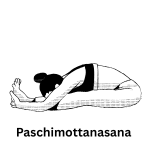
Benefits :- Stretches spine, shoulders, hamstrings. Calms brain, relieves stress and mild depression. Stimulates liver, kidneys, ovaries, uterus. Improves digestion. Can help relieve menopause symptoms and headache.
Precautions :- Avoid if you have asthma, back injury, or diarrhea. Bend knees generously. Use props (blanket under hips, strap around feet). Focus on lengthening spine, not just reaching toes.
10. Savasana (Corpse Pose)
The Integration Lie flat on back, legs slightly apart, feet falling out naturally. Arms away from body, palms facing up. Close eyes. Consciously relax every part of your body, starting from toes to crown of head. Let go of all effort. Breathe naturally, observing the breath without changing it. Surrender completely. Feel Deep, total relaxation; integration of the practice’s benefits; profound peace.
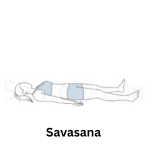
Benefits :- Deeply relaxes the entire body and mind. Lowers blood pressure, reduces stress, anxiety, and fatigue. Improves concentration. Allows the nervous system to integrate the benefits of the practice. Essential!
Precautions :- Stay warm (cover with a blanket). If lying flat is uncomfortable, support knees with a bolster or pillow. Stay awake by maintaining slight awareness of breath.
Types of Yoga
Yoga has many styles, and each type serves a different purpose. Some of the major types include.
1. Hatha Yoga
A gentle form that combines asanas (postures) and pranayama (breathing). Ideal for beginners.
2. Vinyasa Yoga
A dynamic flow that connects breath with movement. Great for flexibility and cardio.
3. Ashtanga Yoga
A structured sequence of poses focusing on discipline, detox, and strength.
4. Kundalini Yoga
Focuses on awakening energy at the spine’s base through chanting, breathwork, and meditation.
5. Iyengar Yoga
Precision and alignment are emphasized using props like belts and blocks.
6. Bikram Yoga
Performed in a heated room, it includes a sequence of 26 postures. Helps with deep detoxification.
7. Restorative Yoga
A calming, slow-paced practice that promotes deep relaxation and recovery.
Benefits of Daily Yoga Practice
| Benefit | Description |
|---|---|
| Physical Health | Increases flexibility, balance, and muscle strength |
| Mental Clarity | Enhances focus, reduces overthinking and stress |
| Emotional Stability | Builds inner strength and peace |
| Detox & Immunity | Flushes toxins, boosts immunity |
| Weight Management | Burns calories, controls appetite |
| Heart Health | Improves circulation and reduces BP |
| Skin & Hair | Glowing skin and strong hair due to better blood flow |
Conclusion: Your Yoga Journey Begins Now
The beauty of Yoga is that it meets you exactly where you are. You don’t need to be flexible, strong, or spiritually enlightened to start. You simply need the willingness to step onto the mat and breathe. Remember, Yoga is a practice, not a perfect pose. It’s about showing up with kindness towards yourself, exploring your edges without judgment, and discovering the incredible potential within your own body and mind.
Start small. Even 10-15 minutes a day can create ripples of positive change. Focus on the basics – your breath, simple poses like Tadasana and Balasana. Consistency matters far more than intensity. As you practice, you’ll naturally build strength, flexibility, and inner calm. Notice how you feel off the mat – calmer in traffic? Sleeping better? More patient? These are the true signs Yoga is working.
Honor this ancient gift from India. Let Yoga be your sanctuary, your strength, and your guide to living a more balanced, vibrant, and meaningful life. Roll out your mat, take a deep breath, and begin. Your journey home to yourself starts now. Namaste. 🙏